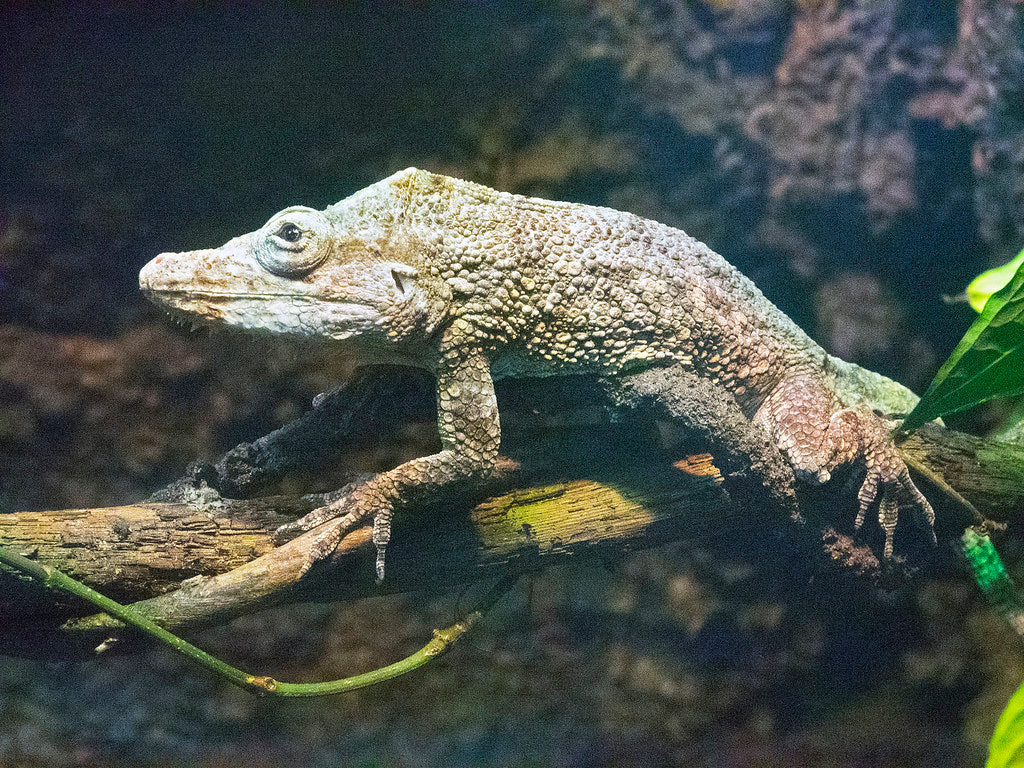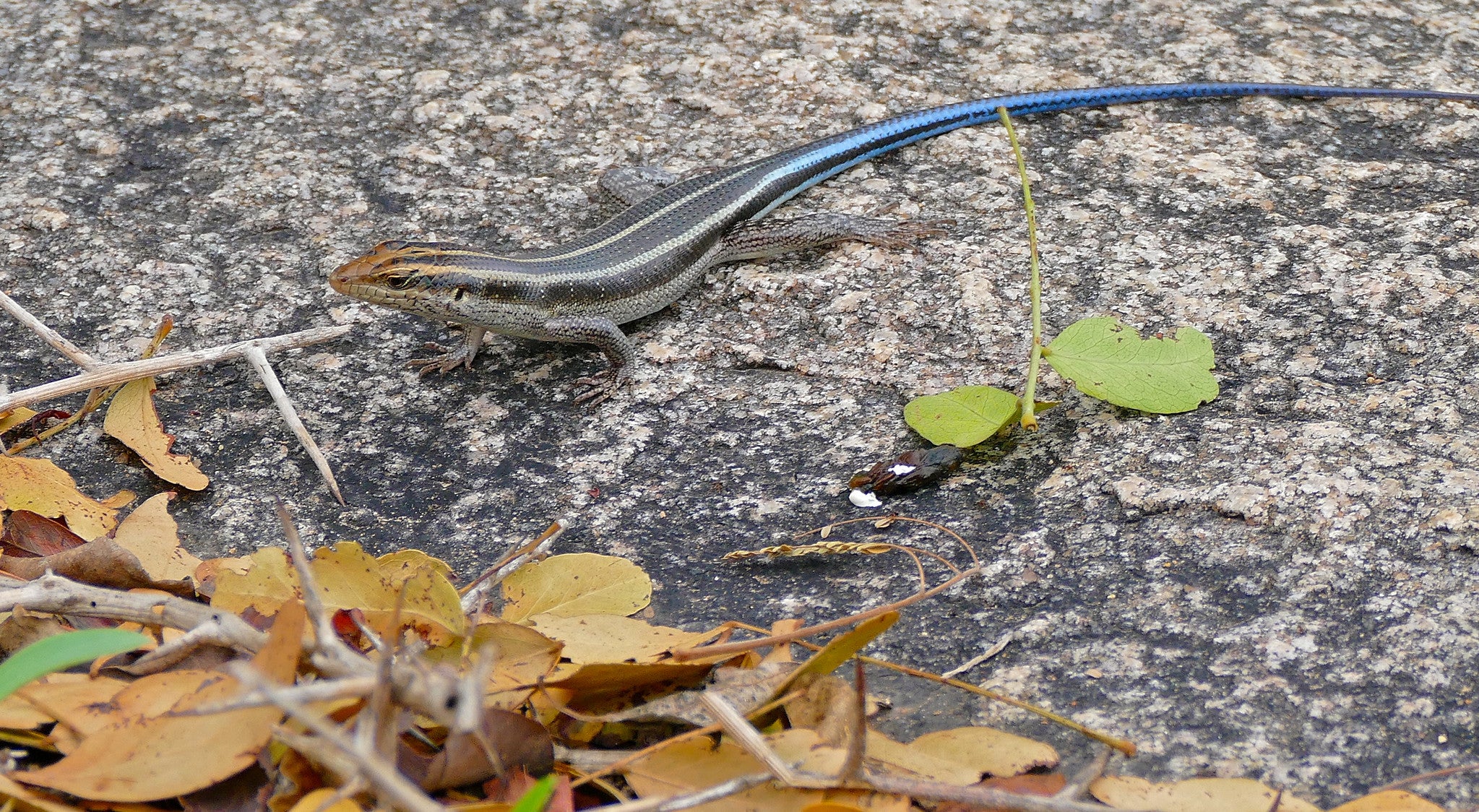Peter’s rock agamas (Agama picticauda) are 12” long, diurnal, terrestrial lizards native to western and central Africa south of the Sahara Desert, although they are also prolifically invasive in Florida, USA. They are particularly common in coastal areas with rocks and trees, and have adapted well to coexisting alongside humans in urban areas.
Peter’s rock agamas are sexually dimorphic, which means that males and female look different. Males have a red or orange head, gray to black body, and a black and orange tail. Females are tan to gray in color. Both sexes have wide mouths, prominent brow ridges, small spikes at the back of the head, rough triangular scales, and robust limbs.
Peter’s rock agamas are best kept as a display animal, but may be tamed with patient effort.
How much space do Peter’s rock agamas need?
A single Peter’s rock agama should be housed in no smaller than a 36”L x 18”W x 16”H enclosure (~40 gallons). However, Peter’s rock agamas are quite active lizards, so if you can provide a larger enclosure, do it!
Cohabitation (housing multiple agamas together) is generally not recommended.
Do Peter’s rock agamas need UVB?
Yes! Peter’s rock agamas are diurnal, which means that they are most active during the day, and naturally exposed to lots of sunlight on a day-to-day basis. This means that they need UVB light as part of their enclosure. The best UVB bulbs for a Peter’s rock agama housed in a 36 x 18 x 16 enclosure are:
- Zoo Med Reptisun T5 HO 10.0, 22”
- Arcadia Desert 12%, 22”
The basking surface should be placed so the lizard’s back will be 8-12” below the lamp when basking. The basking area should be the closest surface to the UVB bulb. The UVB bulb should be housed in a reflective Arcadia or Vivarium Electronics fixture and placed on the basking side along with the heat lamp. UVB is blocked by glass and plastic, so you can’t give your lizard UVB by placing its terrarium in front of an open window.
In addition to UVB, since Peter’s rock agamas are day-active lizards, it’s beneficial to provide an additional daylight-spectrum lamp to make sure the enclosure is brightly illuminated. Use a strong 6500K LED or T5 HO fluorescent plant grow light for best results. This may also encourage better coloration from your lizard!
Peter’s rock agamas should get 12 hours of light per day. Alternatively, you may use a smart timer to sync the lights with your local sunrise and sunset times. This simulates natural seasonal changes in day length and encourages healthier hormonal rhythms.
What basking temperatures do Peter’s rock agamas need?
Peter’s rock agamas should have a moderate basking temperature around 95°F, with ambient/cool side temperatures between 75-85°F. Measure your temperatures with two digital probe thermometers, with the probes placed in the desired areas. Heating should be turned off at night.
Provide heat for your agama by imitating the sun with a heat lamp placed on one side of the enclosure. Do not use ceramic heat emitters (CHEs), heat mats, red bulbs, or blue bulbs, as these are not as effective. For best results, the basking surface itself should be a large, flat piece of rock.
What humidity levels do Peter’s rock agamas need?
Peter’s rock agamas should have an overall average humidity between 70-85%, fluctuating higher at night and lower during the day. Track the humidity levels inside the terrarium by using a digital probe hygrometer, with the probe placed in the middle of the setup.
Maintain the humidity levels that your rock agama needs with a pressure sprayer, misting 2x/day in the morning and evening. Mist again in the afternoon if needed. If you’re struggling to maintain appropriately high humidity levels, automatic misting systems and the use of live plants can be helpful.
What substrate is good for Peter’s rock agamas?
Substrate covers the floor of your lizard’s terrarium and helps make the enclosure more attractive, but it also helps maintain desired humidity levels and provides something for your agama to dig around in.
It’s ideal to use a substrate that imitates the “substrate” that the reptile naturally lives on in the wild. For Peter’s rock agamas, sandy to loamy soil works. We recommend the following substrates for this species:
- Zoo Med ReptiSoil
- Zoo Med Eco Earth
- Exo Terra Plantation Soil
- Zilla Jungle Mix
Substrate should be at least 3” deep for burrowing, and completely replaced every 3-4 months. Remove poop and urates daily, along with contaminated substrate.
What décor can you use in a Peter’s rock agama terrarium?
Peter’s rock agamas should have plenty of enrichment to help keep them busy and entertained. It doesn’t matter how big the enclosure is if you don’t put things in it for your pet to use and interact with.
At bare minimum, you will need at least two hiding places for your pet to use, as well as a flat stone for basking on. However, it’s best to include other items, such as:
- rocks
- ledges
- hollow logs
- branches
- live or artificial plants
What do Peter’s rock agamas eat?
Peter’s rock agamas are primarily insectivorous, which means that they need to eat insects (preferably live) in order to get the nutrition that their bodies need. Offer food every morning, as much as they will clean up within one day. Juveniles will generally eat more than adults do.
Variety is the key to balanced nutrition, so make sure to offer as many different kinds of bugs as possible!
Feeder insects for Peter’s rock agamas: dubias, discoids, red runners, crickets, black soldier fly larvae, hornworms, mealworms, silkworms, wax moths
Although they are insectivores, flowers can make great treats for Peter’s rock agamas! Clean, chemical-free flowers such as marigolds, geranium, clover, dandelions, and hibiscus are safe to use.
Supplements
You will also need calcium and vitamin supplements to prevent your agama from developing a deficiency. We recommend Repashy Calcium Plus LoD, lightly dusted on all of your lizard’s feeder insects.
Water
Your Peter’s rock agama should always have free access to a small water bowl where it can get a drink whenever needed. Change the water daily and scrub the bowl with a reptile-safe disinfectant weekly, or whenever it becomes soiled.
Do Peter’s rock agamas like to be handled?
Few reptiles actually “like” to be held, and although Peter’s rock agamas may learn to tolerate it, you have to work up to it. Instead of interacting with your lizard by holding it right away, start with hand-feeding with a pair of feeding tweezers.
When you start handling your agama, be gentle. Don’t grab the lizard from above, because that will make it afraid of you. Instead, approach from the side and scoop from below. Whenever possible, entice it to come to you first. Support as much of its body as possible, especially its feet. Handle inside the enclosure only at first, and let it come to you whenever possible. Start with very short handling sessions in the beginning, then gradually make them longer as your pet becomes more accustomed to you. Make sure every interaction is a positive one!
*This care sheet contains only very basic information. Although it’s a good introduction, please do further research with high-quality sources to obtain additional information on caring for this species.
"Peters's Rock Agama, Agama picticauda" by J.J. Maughn is licensed under CC BY-NC-ND 2.0.




Leave a comment
This site is protected by hCaptcha and the hCaptcha Privacy Policy and Terms of Service apply.